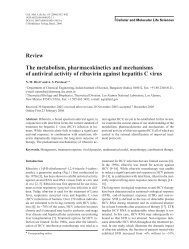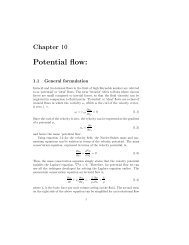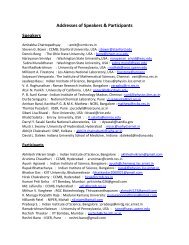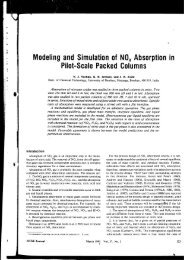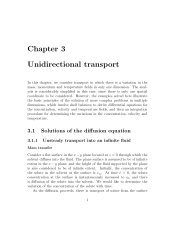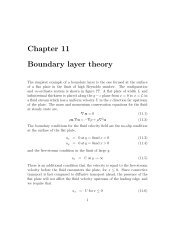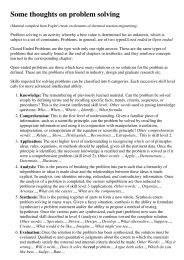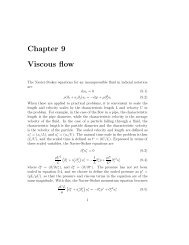Chapter 5 Steady and unsteady diffusion
Chapter 5 Steady and unsteady diffusion
Chapter 5 Steady and unsteady diffusion
You also want an ePaper? Increase the reach of your titles
YUMPU automatically turns print PDFs into web optimized ePapers that Google loves.
4 CHAPTER 5. STEADY AND UNSTEADY DIFFUSION<br />
where the functions C 1n , C 2n , A 1m <strong>and</strong> A 2n are to be determined from the<br />
boundary conditions.<br />
The solutions˚4220 <strong>and</strong>˚4224 are eigenfunctions of Sturm - Liouville equations,<br />
<strong>and</strong> therefore the eigenfunctions are complete <strong>and</strong> orthogonal. This<br />
orthogonality can be used to determine the constants C 1n , C 2n , A 1n <strong>and</strong> A 2n<br />
in ˚4230. The orthogonality of the sine <strong>and</strong> cosine functions are expressed as:<br />
⎡<br />
∫ 2π<br />
0 for m ≠<br />
dφ sin (mφ) sin (m ′ m′<br />
φ) = ⎣ π<br />
0<br />
for m = m ′<br />
⎡ 2<br />
∫ 2π<br />
0<br />
∫ 2π<br />
0<br />
dφ cos (mφ)cos (m ′ φ) = ⎣<br />
dφ sin (mφ)cos (m ′ φ) = ⎢<br />
⎣<br />
⎡<br />
0 for m ≠ m′<br />
π<br />
for m = m ′<br />
2<br />
0 for m ≠ n <strong>and</strong> (m + n) even<br />
2m<br />
m 2 − n 2 for m ≠ n <strong>and</strong> (m + n) odd<br />
0 for m = n<br />
(5.18)<br />
Similarly, the Legendre polynomials also satisfy the following orthogonality<br />
constraints in the interval 0 ≤ θ ≤ π:<br />
⎡<br />
∫ π<br />
0 for n ≠ n ′<br />
dθ Pn m (cos (θ))P n m (cos (θ)) = ⎢<br />
′ ⎣ 2 (n + m)!<br />
0<br />
5.1.1 Diffusion from a sphere<br />
2n + 1 (n − m)!<br />
5.1.2 Effective conductivity of a composite<br />
for n = n ′ (5.19)<br />
A composite material of thickness L consists of a matrix of thermal conductivity<br />
K m , embedded with particles of radius R <strong>and</strong> thermal conductivity<br />
K p . A temperature gradient T ′ is applied across the composite in the x 3<br />
direction, as shown in figure 5.1, <strong>and</strong> it is necessary to determine the heat<br />
flux q 3 as a function of the temperature gradient T ′ in the x 3 direction. It is<br />
assumed that the length L is large compared to the thickness of the particles<br />
R, so that the material can be viewed as a continuum with an effective conductivity<br />
which is determined by the conduction of heat through the particles<br />
<strong>and</strong> the matrix,<br />
q 3 = −K eff T ′ (5.20)<br />
It is necessary to determine K eff as a function of the conductivities of the<br />
particles <strong>and</strong> the matrix.




